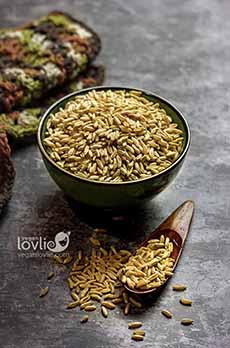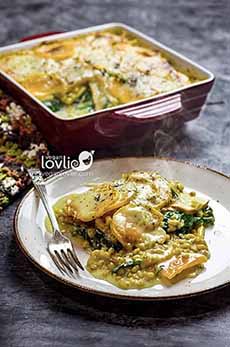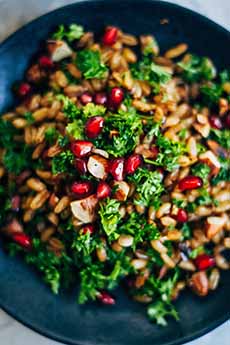TOP PICK OF THE WEEK: Kracklin Kamut®, Khorasan Wheat
|
|
Have you heard of Kamut (kah-MOOT)? If so, do you know what it is? Kamut® is a trademarked brand of khorasan wheat, one of those better-for-you ancient grains you read about. Originally from the Fertile Crescent, Kamut khorasan wheat is grown in the U.S. on certified organic farms, primarily in Montana and other northern Great Plains of the U.S. It is a whole grain. Our Top Pick Of The Week is Kracklin Kamut, one of many products with the grain. You can jump to our review below, or first discover more about Kamut wheat. Kamut is an ancient relative of modern durum wheat, a hard amber spring-type wheat. As an important note, many, if not most, of agricultural products have been bred and re-bred since ancient times. This is done to produce versions that have higher yields, are disease- and weather-resistant, and/or grow better in different climates. In the process, flavor, nutrition and other features are sacrificed. With Kamut, you know you have the real deal, the true ancient grain: nutritious, ancient wheat with a rich, buttery flavor and firm texture (photo # 1). The Kamut brand of khorasan is guaranteed to never be hybridized or genetically modified. It is always organically grown. Khorasan-type wheats originated in the Fertile Crescent, in what is now Mesopotamia. The Quinns coined the trade name “Kamut” an ancient Egyptian word for wheat. Egyptologists claim the root meaning of Kamut is “Soul of the Earth.” Although the Kamut brand wheat is thousands of years old, it was off the radar for a few thousand years. Its resurrection sounds like a tall tale (and in fact it likely is, according to Bob Quinn, founder of Kamut International, the largest grower of khorasan wheat which he branded as Kamut®. Following World War II, a U.S. airman claimed to have taken a handful of grains from a stone box in a tomb near Dashare, Egypt. Thirty-six kernels of the grain were given to a friend who mailed them to his father, a Montana wheat farmer. The farmer planted and harvested a small crop and displayed the grain as a novelty at the local fair. Believing the legend that the giant grain kernels were taken from an Egyptian tomb, the grain was dubbed “King Tut’s Wheat” (source). But soon after, the ancient grain was again all but forgotten. [Farmers in Turkey call the grain “Camel’s Tooth” because of its shape, or the “Prophet’s Wheat,” referring to another legend that Noah brought the grain with him on the ark. Beyond the tomb tale, the grain may in fact have existed in small pockets in Mesopotamia.] Here’s what Bob Quinn calls the more likely story: In 1977, one remaining jar of “King Tut’s Wheat” was obtained by T. Mack Quinn, another Montana wheat farmer—we don’t know from where. He and his son Bob, an agricultural scientist and plant biochemist, soon perceived the value of the unique grain. They spent the next decade propagating some of the humped-backed kernels selected from the small jar. Their research revealed that wheats of this type originated in the Fertile Crescent. The Quinns coined the brand name “Kamut,” an ancient Egyptian word for wheat. Egyptologists say the root meaning of Kamut is “soul of the Earth.” In 1990, the USDA recognized the grain as a protected variety. The Quinns also registered Kamut as a trademark. Perhaps the most significant aspect of the introduction and cultivation of Kamut brand wheat is that it is an important new crop for sustainable agriculture. This grain’s ability to produce high quality without artificial fertilizers and pesticides make it an excellent crop for organic farming (source). When you roast Kamut kernels, you get Kracklin Kamut: a most delightful, crunchy, flavorful, satisfying snack. Made in small batches with Montana-grown Kamut and organic, cold-pressed, hi-oleic safflower oil†. It is lightly seasoned with sea salt from ancient caves in Utah (from a sea that evaporated millions of years ago). Like crunchy corn nuts, we enjoy it as a grab-and-go snack, but this simple, clean roasted grain is delicious on salads—green and fruit—on vegetables, rice and grains. A 1.5-ounce pack has 200 calories, 7 grams of fat, 6 grams of protein and no cholesterol, trans fat or sugar. The product is also USDA organic and non-GMO. It’s available at natural food stores and online. Learn more about it at KracklinKamut.com. Because of its higher nutrition, you can now find Kamut in dozens of products, from baby’s and children’s food and breakfast cereals cold and hot, to energy bars and snacks. Kamut can be found in cereals, breads, cookies, snacks, waffles, pancakes, bread mixes, baked goods, and prepared and frozen meals. Because of the inherent sweetness of the grain (referred to by some as “the sweet wheat”), no added sugar is required to hide the subtle bitterness associated with most wheats and whole wheat products. The natural firmness of the cooked kernels lend themselves to: |
|
|
In addition to Kamut pasta, which has outstanding texture and flavor compared to other whole grain pastas, you can also find Kamut brand bulgur and couscous. You can see a list of Kamut products here. __________________ †High oleic safflower oil is a healthy alternative to saturated or hydrogenated oils. A naturally occurring liquid vegetable oil, it is not chemically modified. It has a neutral flavor and odor.
|
||








